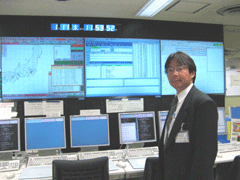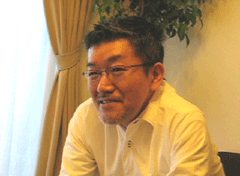Averting Seismic Disaster
Air Date: Week of September 21, 2007

Osamu Kamigaichi in the Japan Meteorological Agency Control Center.(Photo: Jean Kumagi)
Earthquakes are common in Japan and some have devastating consequences. The Japanese government is implementing a seismic warning network that will give residents a few seconds lead time when an earthquake is coming in hopes of averting disaster. Spectrum Radio’s Jean Kumagai reports.
Transcript
CURWOOD: Japan has been hit hard by earthquakes over the years, most recently by a 6.8 trembler in northwestern Japan, that claimed 11 lives and shut down the world’s largest nuclear power plant. So Japan has a strong incentive to figure out how to predict earthquakes and it’s making some progress. The government has developed a sophisticated earthquake-warning system that can sound an alarm a few precious seconds before the most destructive waves of an earthquake hit.
Spectrum Radio’s Jean Kumagai has our story.
[SOUND FROM DISASTER PREVENTION DAY; SIREN]
KUMAGAI: September in Japan always begins the same way: Disaster Prevention Day. Across the country, schoolchildren don protective headgear and practice taking cover under sturdy desks; public-safety workers conduct mock searches and rescues; and medical personnel attend to the faux injured.
[MORE SOUND FROM DISASTER PREVENTION DAY; SHOUTING]
KUMAGAI: This annual ritual underscores a simple fact of life for the Japanese: earthquakes happen. The country experiences more than a thousand earthquakes each year. Most of these are too small to do real damage. But major quakes have claimed hundreds of thousands of lives in Japan over the centuries.
[SOUND: NEWSCASTER REPORTING “THIS MORNING AT FIRST LIGHT, IT WAS IMPOSSIBLE TO DETECT THE TRAUMA THAT HAS HIT THE CITY OF KOBE, ONCE RENOWNED FOR ITS STYLE AND ITS BEAUTY . . . " (FADES)]
KUMAGAI: Just before dawn on January 17, 1995, a magnitude 7.2 earthquake flattened large sections of the city of Kobe. Sixty-four hundred people perished, and many thousands more were injured. Naoko Onda was living outside Kobe when the ground started to move.
ONDA: I was at home and reading a book to be ready to go to work. Suddenly from the bottom under the floor I feel going up, up, up and suddenly lift and suddenly big shake. And I was not able to stand up and the window to the balcony was open, even though it had been locked.

Osamu Kamigaichi in the Japan Meteorological Agency Control Center (Photo: Jean Kumagi)
Data from the seismic stations is routed to the Japan Meteorological Agency, or JMA, in Tokyo. The JMA control center is a large room filled with computers, large flat-screen monitors, and other equipment. At one end, a bank of screens displays various types of seismic data. Osamu Kamigaichi is JMA’s senior coordinator for international earthquake and tsunami information.
KAMIGAICHI: Earthquake early warning is a fully automated system. Otherwise we cannot disseminate timely information to the public.
KUMAGAI: As Kamigaichi talks, the automated system emits a warning.
[WARNING SOUND; BUZZING; AUTOMATED VOICE]
KUMAGAI: It’s a false alarm, and so the warning won’t travel beyond the control center. But in the event of a real earthquake, additional information would soon follow, and an official alert would then be issued. At most, the advance warning amounts to mere seconds.
[WARNING SOUND; BUZZING]
KUMAGAI: That may not seem like a lot of time, but for equipment controlled by a microprocessor, it’s usually long enough to react. For example, elevators tend to jam between floors when strong shaking sends their cables swinging. But with a 10-second lead time, a moving elevator could stop at the closest floor and open its doors. In fact, all 227,000 elevators in Japan must now be equipped with control systems that accept the JMA signals. The alerts could also trigger automated responses at power and chemical plants, computer and communications networks, trains, and hospitals.
[SOUND OF MAN SPEAKING IN JAPANESE]
KUMAGAI: Masanori Kanazawa and his orange tabby cat live in one of the dozen or so apartment complexes in Tokyo that provide the alerts to their residents. During a recent demonstration, he was sitting on his living room couch reading the newspaper when the alarm began to sound.
[SOUND OF HIGH-PITCHED ALARM; AUTOMATED VOICE]
KUMAGAI: As the prerecorded voice counts down the seconds to the earthquake’s arrival, Kanazawa jumps to his feet, pads into the kitchen to check that the gas stove isn’t on, and then heads for the front door, presumably to safety. Kanazawa says all of his friends now want an earthquake warning system, too.
[KANAZAWA SPEAKING IN JAPANESE]
TRANSLATOR: After I bought this apartment, I told my friends about the earthquake early warning system and they said that they envy me. They really think it’s safer to have this system in the house.

Masanori Kanazawa (Photo: Jean Kumagi)
HEATON: Earthquakes are a phenomenon that take us by surprise, they do just tremendous damage—change the state of everything in just a few brief moments, from peacetime into total and utter chaos. One of challenges is to try to deal with that chaos in some new, creative ways. We think the key to that is having good information, as quickly as possible.
KUMAGAI: In other words, the right kind of information can save lives. For Living on Earth, I’m Jean Kumagai.
CURWOOD: Jean Kumagai reports for Spectrum Radio, the broadcast edition of I triple E Spectrum Magazine.
Links
Living on Earth wants to hear from you!
Living on Earth
62 Calef Highway, Suite 212
Lee, NH 03861
Telephone: 617-287-4121
E-mail: comments@loe.org
Newsletter [Click here]
Donate to Living on Earth!
Living on Earth is an independent media program and relies entirely on contributions from listeners and institutions supporting public service. Please donate now to preserve an independent environmental voice.
NewsletterLiving on Earth offers a weekly delivery of the show's rundown to your mailbox. Sign up for our newsletter today!
 Sailors For The Sea: Be the change you want to sea.
Sailors For The Sea: Be the change you want to sea.
 The Grantham Foundation for the Protection of the Environment: Committed to protecting and improving the health of the global environment.
The Grantham Foundation for the Protection of the Environment: Committed to protecting and improving the health of the global environment.
 Contribute to Living on Earth and receive, as our gift to you, an archival print of one of Mark Seth Lender's extraordinary wildlife photographs. Follow the link to see Mark's current collection of photographs.
Contribute to Living on Earth and receive, as our gift to you, an archival print of one of Mark Seth Lender's extraordinary wildlife photographs. Follow the link to see Mark's current collection of photographs.
 Buy a signed copy of Mark Seth Lender's book Smeagull the Seagull & support Living on Earth
Buy a signed copy of Mark Seth Lender's book Smeagull the Seagull & support Living on Earth

